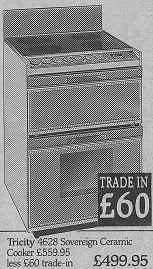On cold wet days there's always something to clear out or tidy up indoors. I've recently been going through some papers which go back decades. I found some cuttings from local newspapers that I evidently found interesting enough to keep at the time.
Now, thirty years later, the advertisements are more interesting than the articles I originally saved.
In 1985 a lady's lambswool sweater cost £17.99. Tweed trousers with turn-ups were £29.99. The great thing about fashion that season, women were told, was the element of choice it offered. Next had four distinct looks; Cross Country, for the independent woman, Dressed for Success for the influential woman, Beatnik Girl for the street look, and Night Club.
Fashion might have been catering for the independent and successful woman, but the toy department sold a 'Housewife Set, complete with brush & pan etc.' for £1.25.
In household fabrics, a single sheet was £6.50. A pair of pillowcases was £3.49. A bath towel was £4.99.
I'm not sure if thirty piece bone china teasets or sets of lead crystal sherry glasses are much in demand in 2015. In 1986 they cost £29.95 and £4.99 respectively from one shop.
The new Renault 11 could be bought for between £5,000 and £6,000 cash, depending on the model.
While many, if not most things, have increased in price over thirty years, others, especially technology and household appliances, have become cheaper, both in relation to incomes and in absolute terms.
One dealer in electrical appliances had microwave ovens starting at £129. At time of writing, Currys cheapest model is £39.99. A fridge-freezer was £152. Currys current cheapest is £169.99. (Regrettably, Currys choose to spell their name without an apostrophe.)
An automatic washing machine could be had for £159 upwards, a tumble drier from £136. Twin tubs and spin driers were also available.
All these goods could be bought in the High Street, with no need to go to an out of town retail park. And of course, online shopping was unheard of.





.jpg)